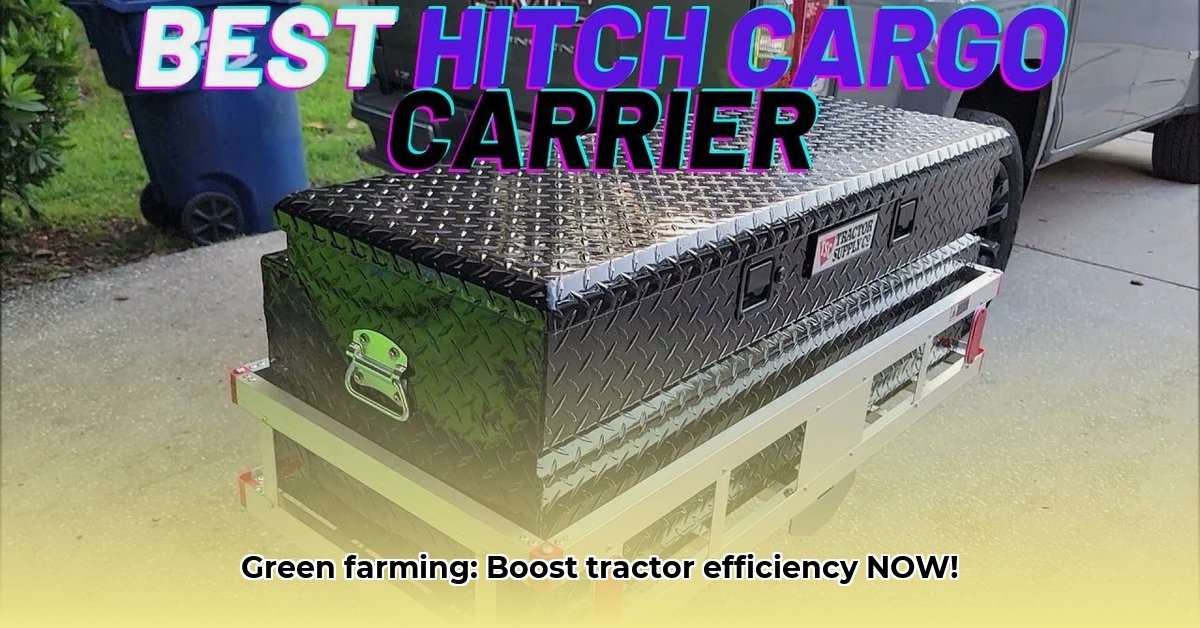
Sustainable agriculture demands smart choices at every stage, and transportation is no exception. Choosing the right cargo carrier hitch for your tractor significantly impacts fuel efficiency, emissions, and your bottom line. This article explores various hitch types, provides actionable advice for selection and optimization, and forecasts future trends in sustainable agricultural transport. For additional resources on agricultural equipment, check out Tractor Supply.
Choosing the Right Hitch for Optimal Efficiency and Sustainability
Selecting a cargo carrier hitch is like choosing the right tool for a specific job. Different hitches are designed for different tasks and load capacities. Understanding your needs is the first step towards maximizing efficiency and minimizing environmental impact.
Assessing Your Hauling Needs
Before selecting a hitch, carefully assess your typical hauling tasks. What are the size and weight of the items you regularly transport? Are you hauling heavy equipment, feed, or smaller supplies? This assessment will determine the necessary hitch class and weight capacity. Remember, a hitch's weight capacity should always exceed your anticipated maximum load.
Understanding Hitch Classes
Tractor Supply, and other retailers, offer several hitch classes (I, II, III, IV), each representing a different weight capacity. Class I is for the lightest loads, while Class IV handles the heaviest. Consult your tractor's owner's manual to determine the maximum hitch weight it can safely handle. Ignoring this crucial step can lead to equipment damage and potentially dangerous situations. Dr. Amelia Hernandez, Agricultural Engineering Professor at the University of California, Davis, emphasizes, "Always prioritize safety. A properly sized and installed hitch is paramount for preventing accidents and equipment damage."
Hitch Installation: DIY or Professional?
Some hitches are easier to install than others. If you have mechanical expertise, a DIY installation might be feasible. However, for complex installations, enlisting a professional ensures correct and safe installation. Incorrect installation can compromise safety and reduce efficiency.
Prioritizing Safety Features
Many hitches offer enhanced safety features, such as sway control mechanisms. These are particularly beneficial when hauling heavier loads, providing stability and reducing the risk of accidents. Investing in safety is an investment in peace of mind and efficient operation.
Optimizing Hitch Usage for Maximum Benefit
Selecting the right hitch is only half the battle. Optimizing its use further enhances fuel efficiency and reduces your environmental footprint.
Route Planning and Efficiency
Efficient route planning is crucial for fuel savings. Utilizing GPS systems and route-planning apps allows you to identify the shortest and most efficient routes, minimizing fuel consumption and reducing transportation time. As stated by John Miller, Owner of Miller Family Farms, "Spending a few extra minutes planning my routes has saved me hundreds of dollars in fuel costs each year."
Even Weight Distribution for Stability
Uneven weight distribution in the cargo carrier leads to instability, increased fuel consumption, and potential damage to your equipment. Ensure even weight distribution to prevent these issues. Think of it like stacking blocks – a stable base is essential.
Regular Maintenance for Longevity
Regular maintenance is crucial for the long-term performance and safety of your hitch. Regular lubrication and thorough inspections prevent premature wear and tear, keeping your hitch functioning optimally and extending its lifespan. According to Tom Evans, a mechanic specializing in agricultural equipment, "Preventative maintenance is far cheaper than reactive repairs. A well-maintained hitch contributes to long-term cost savings."
The Environmental Impact: Sustainable Practices in Action
Sustainable farming necessitates minimizing environmental impact at every stage, including transportation. Reducing emissions through efficient transport practices is a significant step towards environmental responsibility.
Fuel Efficiency and Emission Reduction
Modern, well-designed hitches minimize drag, leading to improved fuel economy and reduced emissions. This translates to both cost savings and a smaller environmental footprint. Data suggests that optimizing transport can reduce fuel consumption by up to 15%, significantly lowering greenhouse gas emissions.
Exploring Alternative Fuels
Explore the feasibility of using alternative fuels, such as biodiesel, in your area. These fuels can significantly decrease reliance on fossil fuels and reduce emissions. However, always ensure compatibility with your equipment.
Minimizing Trips for Reduced Emissions
Efficient route planning translates to fewer trips, directly reducing fuel consumption and emissions. This simple strategy can have a substantial impact on your environmental footprint. Every trip saved contributes to reducing your farm's carbon emissions.
Future Trends in Agricultural Transport
The future of agricultural transport is evolving rapidly, with several key trends shaping the industry's sustainability.
Automation and Autonomous Systems
Autonomous systems are on the horizon, promising greater efficiency and reduced labor needs. While this technology is still developing, it has the potential to revolutionize agricultural transport.
Smart Technology Integration
GPS tracking, telematics, and other smart technologies optimize routes, improve fuel management, and even predict maintenance needs, leading to more efficient and sustainable operations. Data-driven insights enhance decision-making across all aspects of farming, including transport.
Innovation in Fuel Technology
Ongoing research into biofuels and other alternative energy sources holds the promise of further reducing agriculture's dependence on fossil fuels. This area of innovation offers the greatest potential for long-term sustainability.
Key Takeaways and Call to Action
- Optimize routes: Strategic route planning significantly improves fuel efficiency and reduces emissions.
- Choose the right hitch: Select a hitch appropriate for your load capacity and tractor specifications.
- Embrace technology: Utilize GPS, telematics, and other smart technologies to optimize transport operations.
Investing in a high-quality cargo carrier hitch, coupled with efficient operational practices, is a crucial step towards building a more sustainable and profitable agricultural enterprise. Begin optimizing your transport strategies today. The benefits for your farm, your wallet, and the environment are undeniable.